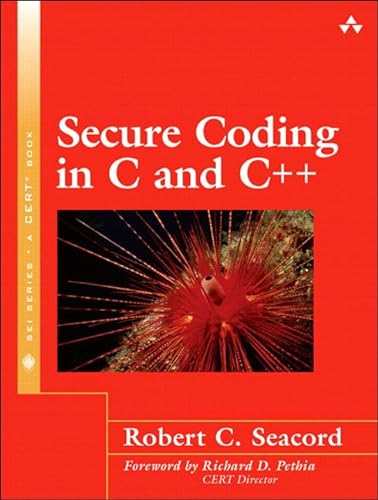
Synopsis
"The security of information systems has not improved at a rate consistent with the growth and sophistication of the attacks being made against them. To address this problem, we must improve the underlying strategies and techniques used to create our systems. Specifically, we must build security in from the start, rather than append it as an afterthought. That's the point of Secure Coding in C and C++.In careful detail, this book shows software developers how to build high-quality systems that are less vulnerable to costly and even catastrophic attack. It's a book that every developer should read before the start of any serious project."
--Frank Abagnale, author, lecturer, and leading consultant on fraud prevention and secure documents
Commonly exploited software vulnerabilities are usually caused by avoidable software defects. Having analyzed nearly 18,000 vulnerability reports over the past ten years, the CERT/Coordination Center (CERT/CC) has determined that a relatively small number of root causes account for most of them. This book identifies and explains these causes and shows the steps that can be taken to prevent exploitation. Moreover, this book encourages programmers to adopt security best practices and develop a security mindset that can help protect software from tomorrow's attacks, not just today's.
Drawing on the CERT/CC's reports and conclusions, Robert Seacord systematically identifies the program errors most likely to lead to security breaches, shows how they can be exploited, reviews the potential consequences, and presents secure alternatives.
Coverage includes technical detail on how to
- Improve the overall security of any C/C++ application
- Thwart buffer overflows and stack-smashing attacks that exploit insecure string manipulation logic
- Avoid vulnerabilities and security flaws resulting from the incorrect use of dynamic memory management functions
- Eliminate integer-related problems: integer overflows, sign errors, and truncation errors
- Correctly use formatted output functions without introducing format-string vulnerabilities
- Avoid I/O vulnerabilities, including race conditions
Secure Coding in C and C++ presents hundreds of examples of secure code, insecure code, and exploits, implemented for Windows and Linux. If you're responsible for creating secure C or C++ software--or for keeping it safe--no other book offers you this much detailed, expert assistance.
"synopsis" may belong to another edition of this title.
About the Author
Robert Seacord began programming (professionally) for IBM in 1982 and has been programming in C since 1985, and in C++ since 1992. Robert is currently a Senior Vulnerability Analyst with the CERT/Coordination Center at the Software Engineering Institute (SEI). He is coauthor of Building Systems from Commercial Components (Addison-Wesley, 2002) andModernizing Legacy Systems (Addison-Wesley, 2003). The CERT/CC, among other security-related activities, regularly analyzes software vulnerability reports and assesses the risk to the Internet and other critical infrastructure.
"About this title" may belong to another edition of this title.
Other Popular Editions of the Same Title
Search results for Secure Coding in C And C++
Secure Coding in C And C++
Seller: Orion Tech, Kingwood, TX, U.S.A.
Paperback. Condition: Good. Seller Inventory # 0321335724-3-29103123
Secure Coding in C And C++
Seller: ThriftBooks-Atlanta, AUSTELL, GA, U.S.A.
Paperback. Condition: Good. No Jacket. Pages can have notes/highlighting. Spine may show signs of wear. ~ ThriftBooks: Read More, Spend Less. Seller Inventory # G0321335724I3N00
Secure Coding in C And C++
Seller: The Maryland Book Bank, Baltimore, MD, U.S.A.
paperback. Condition: Very Good. 1st Edition. Used - Very Good. Seller Inventory # 9-R-5-0162
Secure Coding in C and C++
Seller: Wonder Book, Frederick, MD, U.S.A.
Condition: Good. Good condition. A copy that has been read but remains intact. May contain markings such as bookplates, stamps, limited notes and highlighting, or a few light stains. Seller Inventory # P16E-00896
Secure Coding in C And C++
Seller: Goodbookscafe, Macon, GA, U.S.A.
Condition: good. Used may have minimal highlights, annotations, creases, curled corners, writing on some pages, discoloration, dust from shelves, may need batteries. Seller Inventory # MGV.0321335724.G
Secure Coding in C and C++
Seller: Better World Books Ltd, Dunfermline, United Kingdom
Condition: Very Good. Ships from the UK. Former library book; may include library markings. Used book that is in excellent condition. May show signs of wear or have minor defects. Seller Inventory # 16100074-75
Buy Used
Ships from United Kingdom to U.S.A.
Quantity: 1 available
Secure Coding in C And C++
Seller: Pella Books, Pella, IA, U.S.A.
Trade Paperback. Condition: Used Very Good. Seller Inventory # 236253
Secure Coding in C and C++
Seller: Smith Family Bookstore Downtown, Eugene, OR, U.S.A.
Trade Paperback. Condition: Very Good. text clean and unmarked. binding tight. covers have very light wear along edges and at corners. foredge, head and foot of book are clean. Seller Inventory # 5007122
Secure Coding in C And C++
Seller: SHIMEDIA, Orient, NY, U.S.A.
Condition: New. Satisfaction Guaranteed or your money back. Seller Inventory # 0321335724
Secure Coding in C And C++
Seller: BennettBooksLtd, San Diego, NV, U.S.A.
Paperback. Condition: New. In shrink wrap. Looks like an interesting title! Seller Inventory # Q-0321335724

